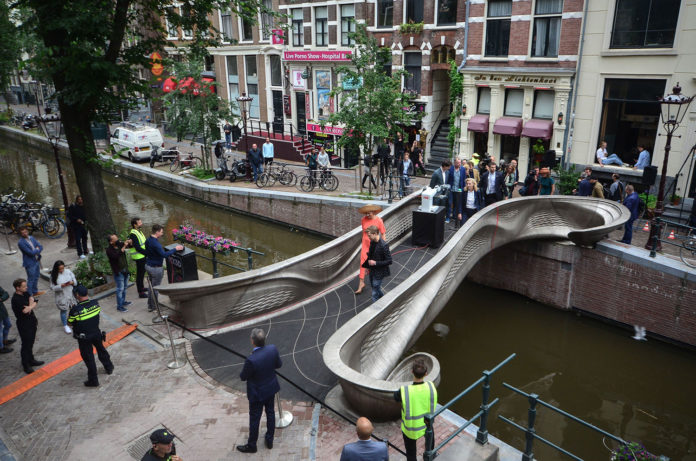Construction technology continues to evolve, including the creation of a variety of infrastructure, including three-dimensional (3D) prints. 3D printing allows you to create free-form structures in a single piece, which reduces the consumption of materials.
Now, the world’s first 3D-printed steel structure, a ‘living laboratory’ bridge, has been unveiled by a robot in Amsterdam. This pedestrian bridge with smart sensors will replace the old bridge under external restoration for the next two years.
The 3D-printed footbridge, which is over four years in the making, is the result of a unique collaboration between MX3D, software company Autodesk, chief engineer Arup, steel giant ArcelorMittal, the City of Amsterdam, and the University of Twente, among others.
MX3D made this design possible by turning welding robots with intelligent software into industrial 3D printers. The entire bridge is made of stainless steel and weighs 6,000 kg. The footbridge will be extensively tested by Imperial College London, with the help of the University of Twente, before being installed.
Using its vast network of installed sensors, researchers will measure, monitor, and analyze the performance of the novel 12-meter-long structure as it handles pedestrian traffic. The data collected will enable researchers and engineers to measure the bridge’s ‘health’ in real-time, monitor how it changes over its lifespan, and understand how the public interacts with 3D-printed infrastructure.
The data from the sensors will be put into a ‘digital twin’ of the bridge – a computerized version that will imitate the physical bridge with growing accuracy in real-time as sensor data come in. The performance and behavior of the physical bridge will be tested against the twin, which will help answer questions about the long-term behavior of 3D-printed steel, as well as its use in real-world settings and in future novel construction projects.
The data captured from the 3D-printed footbridge will be made available to other researchers worldwide who want to work with the Turing researchers in analyzing the data. Now the bridge is unveiled, the researchers will begin collecting data in real-time to monitor how it behaves.
